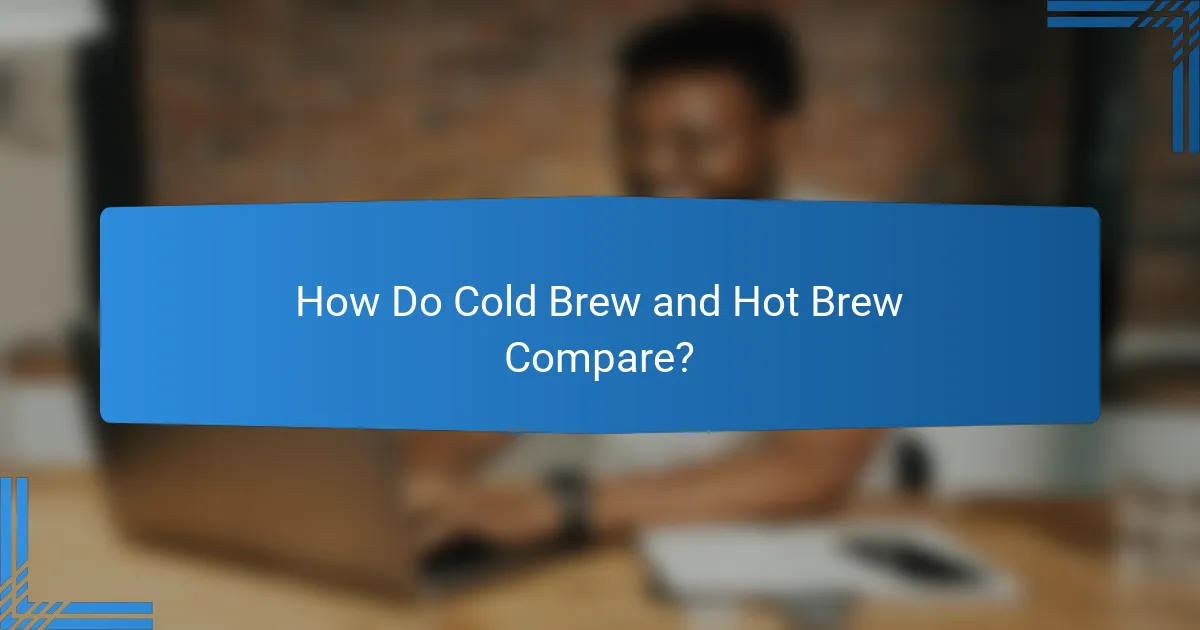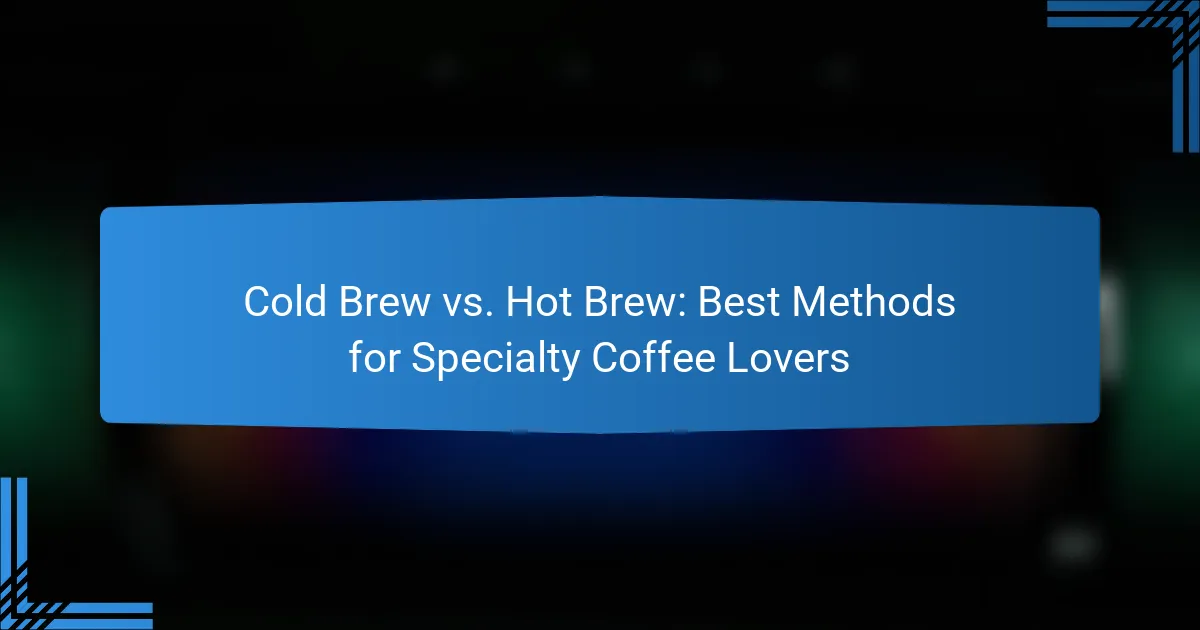For specialty coffee lovers, the choice between cold brew and hot brew methods can significantly influence the flavor and experience of their coffee. Cold brew techniques emphasize a smooth, less acidic profile, while hot brew methods focus on extracting rich flavors and aromas. Understanding the unique characteristics of each brewing style is essential for selecting the best method that aligns with personal taste and preferences.

What Are the Best Methods for Cold Brew Coffee?
The best methods for cold brew coffee include various techniques that emphasize a smooth, less acidic flavor profile. Each method offers unique characteristics and requires specific equipment or ingredients, making it essential for specialty coffee lovers to choose the one that suits their taste and brewing style.
Immersion Method
The immersion method involves steeping coarsely ground coffee in cold water for an extended period. Typically, this method requires a coffee-to-water ratio of about 1:4 to 1:8, depending on your desired strength. After steeping for 12 to 24 hours, strain the mixture through a fine mesh or coffee filter to separate the grounds.
This method is straightforward and allows for a rich extraction of flavors, making it a popular choice for home brewers. However, be mindful of the steeping time; too long can lead to over-extraction and bitterness.
Cold Drip Method
The cold drip method uses a specialized apparatus to slowly drip cold water over coffee grounds. This process typically takes several hours, with a ratio of about 1:5 coffee to water. The slow extraction results in a concentrated coffee that is often smoother and more nuanced than immersion methods.
This technique requires more equipment and attention but can yield a complex flavor profile. It’s ideal for those who enjoy experimenting with different brewing variables, such as drip rate and grind size.
French Press Method
The French press method is another effective way to make cold brew. Start by mixing coarsely ground coffee with cold water at a ratio of about 1:4. Let it steep for around 12 to 18 hours before pressing down the plunger to separate the grounds.
This method is easy to execute and doesn’t require any special equipment beyond the French press itself. However, be cautious with the steeping time to avoid bitterness, as the French press allows for more oils and sediments to remain in the final brew.
Recommended Coffee Beans
Freshness is key; always use recently roasted beans for the best flavor. Consider purchasing whole beans and grinding them just before brewing to maximize aroma and taste.
Brewing Time and Ratio
Brewing time and coffee-to-water ratios are crucial for achieving the desired flavor in cold brew. Generally, a steeping time of 12 to 24 hours is recommended, with a coffee-to-water ratio ranging from 1:4 to 1:8, depending on your taste preference.
Experiment with these variables to find your ideal balance. If you prefer a stronger brew, use a higher coffee ratio or extend the steeping time, but be cautious of over-extraction, which can lead to undesirable bitterness.

What Are the Best Methods for Hot Brew Coffee?
The best methods for hot brew coffee focus on extracting rich flavors and aromas from coffee beans. Techniques such as pour over, French press, and espresso each offer unique characteristics and require specific equipment and skills.
Pour Over Method
The pour over method involves manually pouring hot water over coffee grounds in a filter. This technique allows for precise control over brewing time and water temperature, resulting in a clean and flavorful cup. Popular pour over devices include the Hario V60 and Chemex.
To achieve optimal results, use a medium grind and a water-to-coffee ratio of about 15:1. Pour in a circular motion to ensure even saturation of the grounds.
French Press Method
The French press method immerses coffee grounds in hot water, allowing for full extraction of flavors. This method results in a rich, full-bodied brew with a heavier mouthfeel. The process requires a coarser grind and typically a steeping time of four to five minutes.
After steeping, press down the plunger slowly to separate the grounds from the liquid. For best results, use a ratio of 1:15 coffee to water.
Espresso Method
Espresso is made by forcing hot water through finely-ground coffee under high pressure, producing a concentrated shot of coffee. This method requires an espresso machine and a very fine grind. The brewing time is typically around 25-30 seconds.
Espresso serves as the base for many coffee drinks, such as lattes and cappuccinos. A standard espresso shot uses about 18-20 grams of coffee for a double shot.
Recommended Coffee Beans
For hot brew coffee, choose high-quality, freshly roasted beans that suit your preferred brewing method. Light to medium roasts work well for pour over, while darker roasts are often favored for French press and espresso.
Look for beans labeled as specialty coffee, which indicates a higher quality and unique flavor profile. Local roasters often provide a variety of options to explore.
Brewing Temperature and Time
The ideal brewing temperature for hot coffee is typically between 90-96°C (194-205°F). Each method has its own recommended brewing time, which can significantly affect flavor extraction.
For pour over, aim for a brewing time of about 3-4 minutes, while French press should steep for 4-5 minutes. Espresso requires a quick extraction of 25-30 seconds. Adjusting these variables can help you achieve the perfect cup based on your taste preferences.

How Do Cold Brew and Hot Brew Compare?
Cold brew and hot brew methods yield distinct flavors and characteristics in coffee, making them appealing to different preferences. Understanding their differences can help specialty coffee lovers choose the best brewing method for their taste and lifestyle.
Taste Differences
Cold brew coffee typically has a smoother, less acidic flavor profile, often described as sweet and mellow. This is due to the longer extraction time and lower brewing temperature, which reduces bitterness.
In contrast, hot brew coffee tends to have a brighter and more complex flavor, highlighting the coffee’s natural acidity and aroma. The heat extracts oils and compounds more efficiently, resulting in a richer taste experience.
Caffeine Content
Cold brew coffee generally contains higher caffeine levels due to the longer steeping process, which can extract more caffeine from the coffee grounds. A typical serving of cold brew can have around 100-200 mg of caffeine, depending on the coffee-to-water ratio.
Hot brew coffee usually has lower caffeine content per serving, averaging around 80-120 mg. However, this can vary based on the brewing method and coffee type used.
Acidity Levels
Cold brew coffee is known for its low acidity, making it easier on the stomach for those sensitive to acidic beverages. The cold extraction process minimizes the release of certain acids that contribute to bitterness.
Hot brew coffee, on the other hand, tends to have higher acidity levels, which can enhance flavor complexity but may be less suitable for individuals with acid sensitivity.
Preparation Time
Cold brew requires a longer preparation time, typically ranging from 12 to 24 hours for optimal extraction. This slow process allows for a smoother taste but requires planning ahead.
Hot brew coffee is much quicker to prepare, often taking just a few minutes. Methods like pour-over or espresso can yield a cup in under five minutes, making it a convenient choice for those in a hurry.

What Are the Health Benefits of Cold Brew vs. Hot Brew?
Cold brew and hot brew coffee each offer unique health benefits that can appeal to different preferences. Cold brew is generally lower in acidity, while hot brew may provide higher antioxidant levels, impacting digestion and overall health.
Lower Acidity Benefits
Cold brew coffee typically has a lower acidity compared to hot brew, making it gentler on the stomach. This can be particularly beneficial for individuals with acid reflux or sensitive digestive systems. By steeping coffee grounds in cold water for an extended period, usually 12 to 24 hours, the resulting beverage retains a smoother flavor profile with reduced acidity.
For those who enjoy coffee but experience discomfort from traditional brews, switching to cold brew can alleviate these issues. Many specialty coffee shops now offer cold brew options, making it easier to find a suitable choice.
Antioxidant Levels
Hot brew coffee tends to have higher antioxidant levels due to the brewing process, which extracts beneficial compounds more effectively at higher temperatures. Antioxidants are important for combating oxidative stress in the body and may contribute to overall health. Studies suggest that hot coffee can contain a significant amount of antioxidants, which can help reduce inflammation and improve heart health.
While cold brew has some antioxidants, the extraction process is less efficient, leading to lower concentrations. Coffee lovers seeking the maximum health benefits may want to consider incorporating both brewing methods into their routine.
Hydration Effects
Cold brew coffee can be more hydrating than hot brew due to its lower caffeine content per ounce, depending on the brewing method. This makes it a refreshing option, especially in warmer weather. Staying hydrated is crucial for maintaining energy levels and overall health, and cold brew can serve as a tasty alternative to sugary drinks.
However, it’s important to note that while coffee contributes to hydration, it should not replace water entirely. Balancing coffee consumption with adequate water intake is essential for optimal hydration and health.

What Equipment Do You Need for Each Brewing Method?
To brew cold brew and hot brew coffee, you’ll need specific equipment tailored to each method. Understanding the necessary tools will help you achieve the best flavor and extraction for your specialty coffee.
Cold Brew Equipment
For cold brew, you typically need a large jar or pitcher, a coarse coffee grinder, and a fine mesh strainer or a dedicated cold brew coffee maker. The coarse grind is crucial as it allows for a smoother extraction over the long steeping time.
When preparing cold brew, aim for a coffee-to-water ratio of about 1:4 to 1:8, depending on your taste preference. After steeping for 12 to 24 hours in the refrigerator, strain the mixture to separate the grounds from the liquid.
Consider using a scale for precise measurements, and experiment with steeping times to find your ideal flavor profile. Avoid using hot water, as it can lead to over-extraction and bitterness.
Hot Brew Equipment
Hot brew coffee requires a coffee maker, pour-over dripper, or French press, along with a burr grinder for a consistent grind size. The grind should be medium to medium-fine, depending on your brewing method.
For hot brewing, a common coffee-to-water ratio is around 1:15 to 1:18. Brew times vary: drip coffee makers typically take 5 to 10 minutes, while pour-over methods may take 3 to 4 minutes. Adjust your grind size and brewing time to achieve the desired strength.
Ensure your water temperature is between 195°F and 205°F (90°C to 96°C) for optimal extraction. Avoid boiling water, as it can scorch the coffee and negatively affect the flavor.
